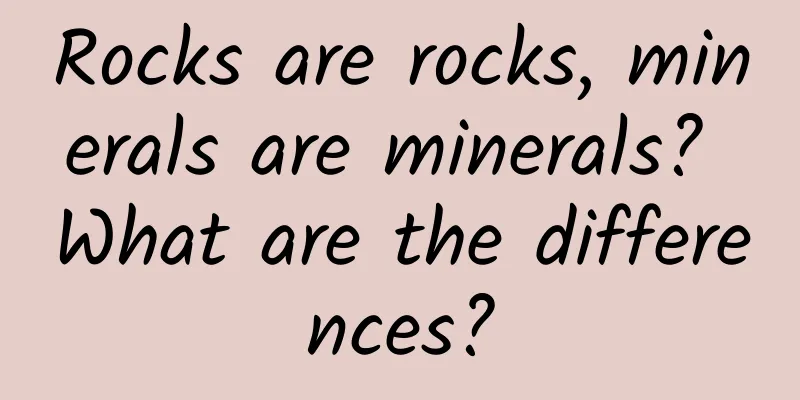Rocks are rocks, minerals are minerals? What are the differences?

|
Tuchong Creative First, let's look at the definition of what a mineral is. A mineral is a natural single substance or compound formed by geological processes. It has a fixed chemical composition and physical properties. For example, quartz feldspar is the basic unit that makes up a rock. This is a mineral. What is rock? Rock is a collection of one or more minerals with certain chemical composition and physical properties. Rock is the main material that makes up the crust or upper mantle. The granite, basalt, limestone, sandstone, etc. that we are familiar with are all rocks. The relationship between minerals and rocks is like a dish. Take fried tomato and eggs as an example. The dish of fried tomato and eggs is the rock, and the tomatoes, eggs and seasonings are the minerals. So the relationship between minerals and rocks is a subordinate relationship. There are nearly 6,000 minerals found on Earth. How should we remember so many minerals? When naming, mineralogists will give different names according to the properties of the minerals. But there are still certain rules. For example, quartz can be called crystal when it becomes this kind of crystal. Some students may have heard of limestone and olivine. The names of these minerals all end with "stone". This is a very large category of minerals, which is called stone. Another interesting category is minerals ending with "ore", such as ferrocene, ferrocopper ore, galena, etc. Those ending with "ore" are all metal minerals. There are also the granite, basalt, limestone, and sandstone that we just mentioned, all of which are followed by the word "yak". Therefore, we can use the names of these rocks and minerals to distinguish whether they are rocks or minerals. Just now I mentioned that there are about 6,000 kinds of minerals. In fact, there are also hundreds of kinds of rocks. How can we distinguish so many rocks? Geologists classify all rocks according to their origins. They are mainly divided into three categories: igneous rocks, sedimentary rocks and metamorphic rocks. The so-called igneous rock is a type of rock that is gradually formed during the process of magma rising and cooling. Sedimentary rock is a type of rock that is gradually deposited by weathering, erosion and transportation under external forces. This type of rock must be deposited in an area, such as rivers, lakes, and the sea, so it is also called sedimentary rock. This type of rock has a characteristic, that is, it has this layered structure. Sandstone, shale, conglomerate, etc. are sedimentary rocks. The last category is called metamorphic rock. What is metamorphic rock? Metamorphic rocks are formed by the combination of igneous rocks and sedimentary rocks in the earth's interior under certain temperature and pressure. This type of rock is called metamorphic rock. Metamorphic rocks often retain some characteristics of the original rocks, such as granite gneiss. It is a type of rock formed by granite undergoing certain metamorphism. Therefore, it also retains certain properties of granite, including structure and texture. These three types of rocks can be transformed, and the process of transformation is called rock cycle. This article is a work supported by the Science Popularization China Creation Cultivation Program Author: Dong Hanwen, Ph.D. in Structural Geology Reviewer: Gao Yuan, Associate Researcher, National Museum of Natural History Produced by: China Association for Science and Technology Department of Science Popularization Producer: China Science and Technology Press Co., Ltd., Beijing Zhongke Xinghe Culture Media Co., Ltd. |
<<: Millennium Populus euphratica, is it really 1,000 years old?
Recommend
Fish's memory not only exceeds 7 seconds, some fish may also have prehistoric memory
Produced by: Science Popularization China Produce...
The efficacy and function of yellow tea root
Yellow tea root is a traditional Chinese medicine...
They come from Lingnan and are full of infinite magic.
Mr. Qiu is good at absorbing the experience of ol...
What are the effects of traditional Chinese medicine Astragalus
Many people want to know the various effects of A...
With an accuracy rate of only 15%, GPT-4 is far inferior to humans?
Currently, large language models (LLMs) may be th...
What are the medicinal properties of Atractylodes macrocephala
Maybe many of us don’t know much about the medici...
The efficacy and function of Gentiana lutea
In modern life, everyone is very familiar with va...
The "super racetrack" of the microscopic world: China plans to build the world's most powerful "particle bumper car"
Produced by: Science Popularization China Author:...
Curiosity made a major discovery: the lakes on Mars were once frozen due to the cold, and there is also a carbon cycle!
[Mobile software: Bo Ke Yuan] By studying the che...
Can oxygen-enriched water replenish oxygen in the body? It is useless and unnecessary
The article is produced by "Science Refutes ...
How many grams of angelica is usually used?
Angelica is a very common herb in traditional Chi...
How to soak fresh monk fruit in water?
Many people know that monk fruit can be used to m...
What is it like to go on an Antarctic expedition?
Antarctica is a cold and mysterious continent, co...
[Cultivation Program] In the hot summer, insects have a "cool way" to escape the heat
Author: Lao Ke’s Brain Studio Withered vines, old...









